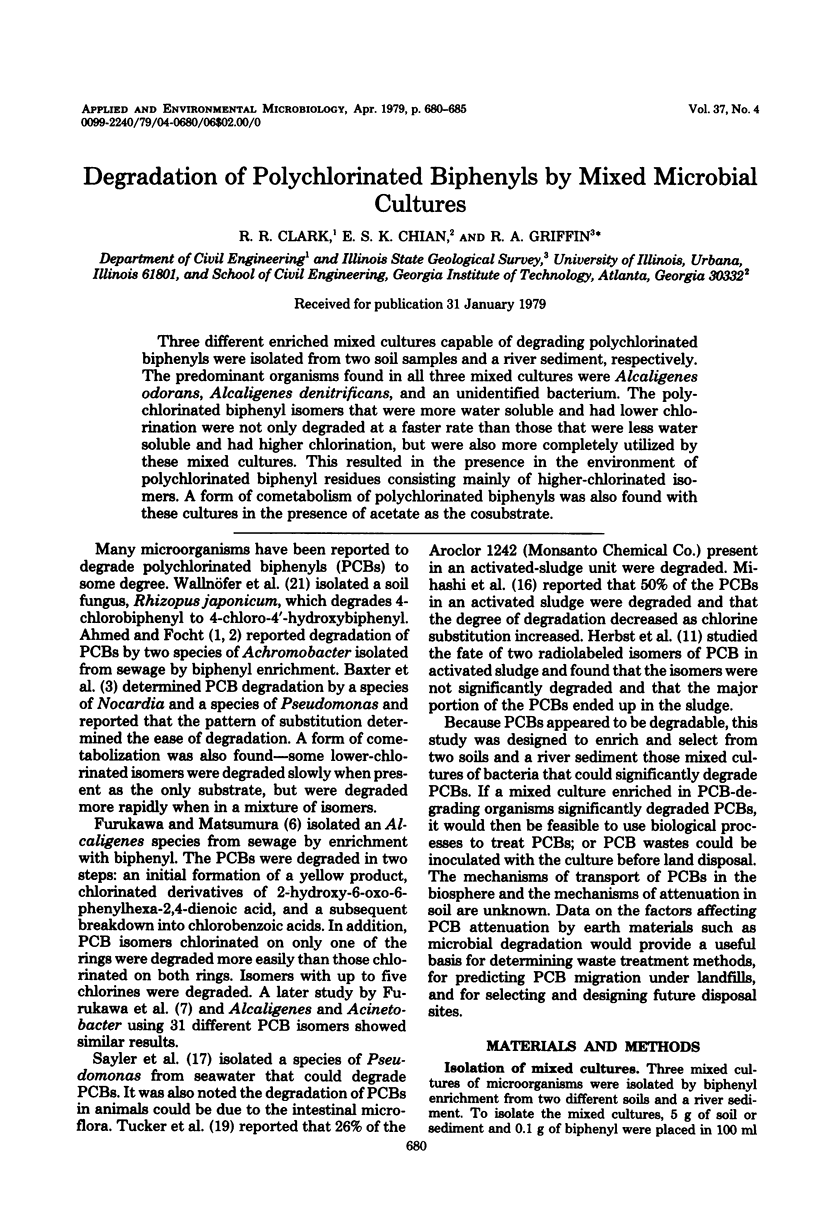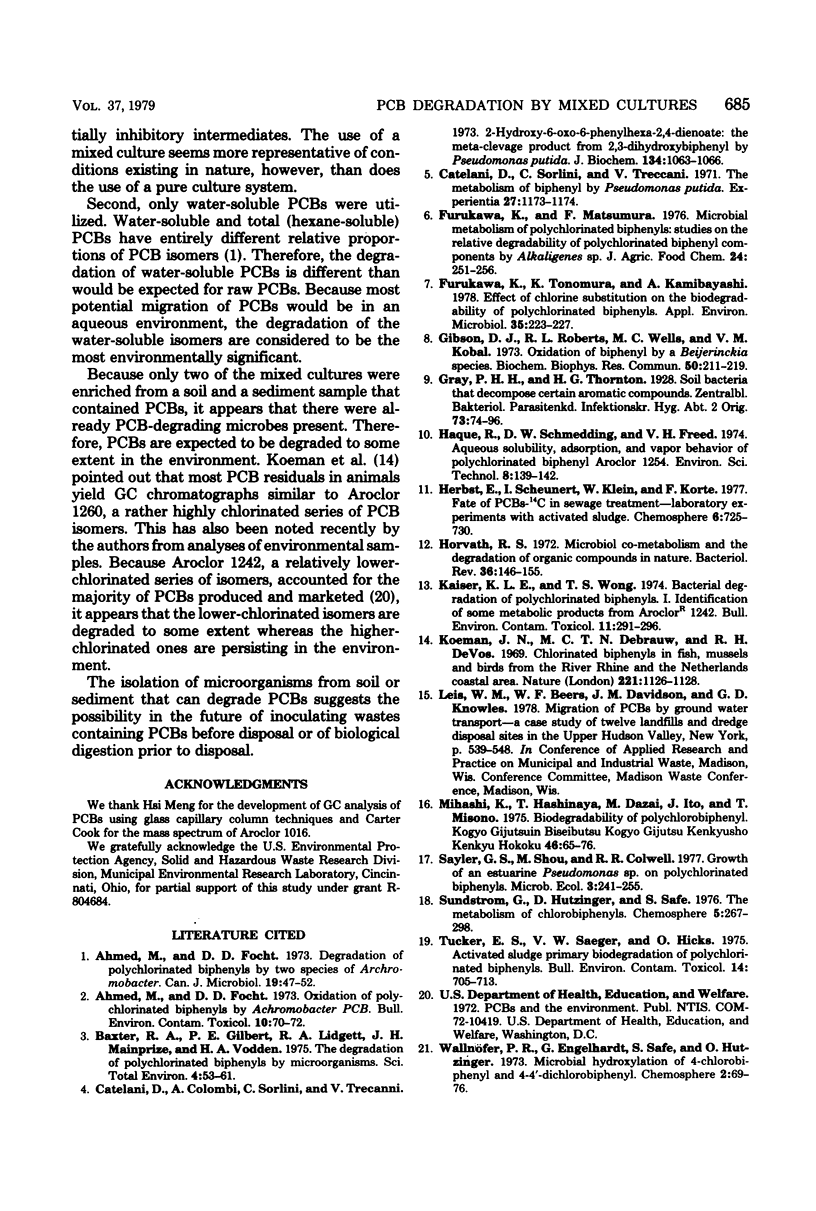Abstract
Three different enriched mixed cultures capable of degrading polychlorinated biphenylas were isolated from two soil samples and a river sediment, respectively. The predominant organisms found in all three mixed cultures were Alcaligenes odorans, Alcaligenes dentrificans, and an unidentified bacterium. The polychlorinated biphenyl isomers that were more water soluble and had lower chlorination were not only degraded at a faster rate than those that were less water soluble and had higher chlorination, but were also more completely utilized by these mixed cultures. This resulted in the presence in the environment of polychlorinated biphenyl residues consisting mainly of higher-chlorinated isomers. A form of cometabolism of polychlorinated biphenyls was also found with these cultures in the presence of acetate as the cosubstrate.
Full text
PDF





Selected References
These references are in PubMed. This may not be the complete list of references from this article.
- Ahmed M., Focht D. D. Degradation of polychlorinated biphenyls by two species of Achromobacter. Can J Microbiol. 1973 Jan;19(1):47–52. doi: 10.1139/m73-007. [DOI] [PubMed] [Google Scholar]
- Ahmed M., Focht D. D. Oxidation of polychlorinated biphenyls by achromobacter pCB. Bull Environ Contam Toxicol. 1973 Aug;10(2):70–72. doi: 10.1007/BF01685874. [DOI] [PubMed] [Google Scholar]
- Baxter R. A., Gilbert P. E., Lidgett R. A., Mainprize J. H., Vodden H. A. The degradation of polychlorinated biphenyls by micro-organisms. Sci Total Environ. 1975 May;4(1):53–61. doi: 10.1016/0048-9697(75)90014-5. [DOI] [PubMed] [Google Scholar]
- Catelani D., Colombi A., Sorlini C., Treccani V. Metabolism of biphenyl. 2-Hydroxy-6-oxo-6-phenylhexa-2,4-dienoate: the meta-cleavage product from 2,3-dihydroxybiphenyl by Pseudomonas putida. Biochem J. 1973 Aug;134(4):1063–1066. doi: 10.1042/bj1341063. [DOI] [PMC free article] [PubMed] [Google Scholar]
- Catelani D., Sorlini C., Treccani V. The metabolism of biphenyl by Pseudomonas putida. Experientia. 1971 Oct 15;27(10):1173–1174. doi: 10.1007/BF02286908. [DOI] [PubMed] [Google Scholar]
- Furukawa K., Matsumura F. Microbial metabolism of polychlorinated biphenyls. Studies on the relative degradability of polychlorinated biphenyl components by Alkaligenes sp. J Agric Food Chem. 1976 Mar-Apr;24(2):251–256. doi: 10.1021/jf60204a002. [DOI] [PubMed] [Google Scholar]
- Furukawa K., Tonomura K., Kamibayashi A. Effect of chlorine substitution on the biodegradability of polychlorinated biphenyls. Appl Environ Microbiol. 1978 Feb;35(2):223–227. doi: 10.1128/aem.35.2.223-227.1978. [DOI] [PMC free article] [PubMed] [Google Scholar]
- Gibson D. T., Roberts R. L., Wells M. C., Kobal V. M. Oxidation of biphenyl by a Beijerinckia species. Biochem Biophys Res Commun. 1973 Jan 23;50(2):211–219. doi: 10.1016/0006-291x(73)90828-0. [DOI] [PubMed] [Google Scholar]
- Horvath R. S. Microbial co-metabolism and the degradation of organic compounds in nature. Bacteriol Rev. 1972 Jun;36(2):146–155. doi: 10.1128/br.36.2.146-155.1972. [DOI] [PMC free article] [PubMed] [Google Scholar]
- Kaiser K. L., Wong P. T. Bacterial degradation of polychlorinated biphenyls. I. Identification of some metabolic products from Aroclor 1242. Bull Environ Contam Toxicol. 1974 Mar;11(3):291–296. doi: 10.1007/BF01685111. [DOI] [PubMed] [Google Scholar]
- Koeman J. H., ten Noever de Brauw M. C., de Vos R. H. Chlorinated biphenyls in fish, mussels and birds from the River Rhine and the Netherlands coastal area. Nature. 1969 Mar 22;221(5186):1126–1128. doi: 10.1038/2211126a0. [DOI] [PubMed] [Google Scholar]
- Tucker E. S., Saeger V. W., Hicks O. Activated sludge primary biodegradation of polychlorinated biphenyls. Bull Environ Contam Toxicol. 1975 Dec;14(6):705–713. doi: 10.1007/BF01685246. [DOI] [PubMed] [Google Scholar]


